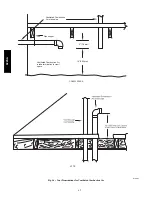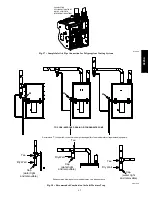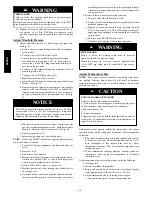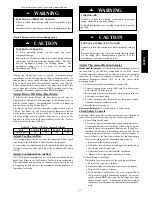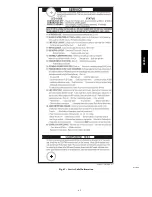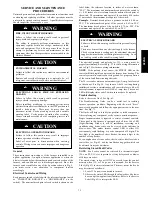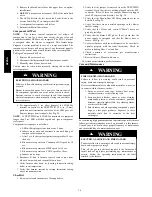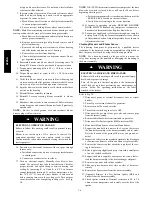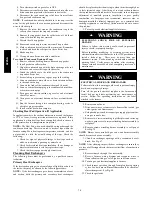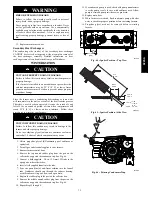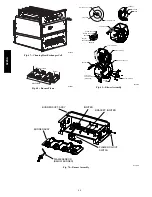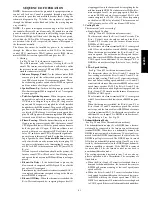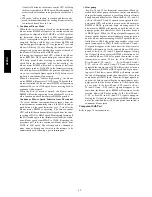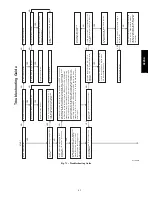
76
(clips) on blower wheel vanes. Do not bend wheel or blades
as balance will be affected.
7. If greasy residue is present on blower wheel, remove wheel
from the blower housing and wash it with an appropriate
degreaser. To remove wheel:
a. Mark blower wheel location on shaft before disassembly
to ensure proper reassembly.
b. Loosen setscrew holding blower wheel on motor shaft.
NOTE:
Mark blower mounting arms and blower housing so each
arm is positioned at the same hole location during reassembly.
c. Mark blower wheel orientation and cutoff plate location to
ensure proper reassembly.
d. Remove screws securing cutoff plate and remove cutoff
plate from housing.
e. Remove bolts holding motor mounts to blower housing
and slide motor and mounts out of housing.
f. Remove blower wheel from housing.
g. Clean wheel per instructions on degreaser cleaner. Do not
get degreaser in motor.
8. Reassemble motor and blower wheel by reversing items 7b
through 7f. Ensure wheel is positioned for proper rotation.
9. Torque motor mounting bolts to 40 +/-- 10 lb--in. when re-
assembling.
10. Torque blower wheel set screw to 160 +/-- 20 lb--in. when
reassembling.
11. Verify that blower wheel is centered in blower housing and
set screw contacts the flat portion of the motor shaft. Loosen
set screw on blower wheel and reposition if necessary.
12. Spin the blower wheel by hand to verify that the wheel does
not rub on the housing.
13. Reinstall blower assembly in furnace.
14. Reinstall 2 screws securing blower assembly to blower
deck.
15. Reconnect blower leads to furnace control. Refer to furnace
wiring diagram, and connect thermostat leads if previously
disconnected.
NOTE:
Be sure to attach ground wire and reconnect blower
harness plugs to blower motor.
ELECTRICAL OPERATION HAZARD
Failure to follow this warning could result in personal injury
or death.
Blower door switch opens 115--v power to control. No
component operation can occur unless switch is closed.
Caution must be taken when manually closing this switch for
service purposes.
!
WARNING
16. Downflow or horizontal furnaces with vent pipe through
furnace only:
a. Install and connect short piece of vent pipe inside furnace
to existing vent.
b. Connect vent connector to vent elbow.
17. Turn on electrical supply. Manually close blower door
switch. Use a piece of tape to hold switch closed. Check for
proper rotation and speed changes between heating and
cooling by jumpering R to G and R to Y/Y2 on furnace
control thermostat terminals. If outdoor temperature is be-
low 70
_
F (21
_
C), turn off circuit breaker to outdoor unit
before running furnace in the cooling cycle. Turn outdoor
circuit breaker on after completing cooling cycle. See Fig.
38.
NOTE
: If R--W/W1 thermostat terminals are jumpered at the time
blower door switch is closed, blower will run for 90 sec before
beginning a heating cycle.
a. Perform component self--test as shown at the bottom of the
SERVICE label, located on the control door.
b. Verify blower is rotating in the correct direction
18. If furnace is operating properly, RELEASE BLOWER
DOOR SWITCH. Remove any jumpers or reconnect any
disconnected thermostat leads. Replace blower door.
19. Turn on gas supply and cycle furnace through one complete
heating cycle. Verify the furnace temperature rise as shown
in Adjustments Section. Adjust temperature rise as shown in
Adjustments Section.
Cleaning Burners and Flame Sensor
The following items must be performed by a qualified service
technician. If the burners develop an accumulation of light dirt or
dust, they may be cleaned by using the following procedure:
NOTE
: Use a back-up wrench on the gas valve to prevent the
valve from rotating on the manifold or damaging the mounting to
the burner assembly.
ELECTRICAL SHOCK AND FIRE HAZARD
Failure to follow this warning could result in personal injury,
death, and/or property damage.
Turn off the gas and electrical supplies to the furnace and
install lockout tag before performing any maintenance or
service. Follow the operating instructions on the label
attached to the furnace.
!
WARNING
Refer to Fig
.
70.
1. Disconnect power at external disconnect, fuse or circuit
breaker.
2. Turn off gas at external shut-off or gas meter.
3. Remove control door and set aside.
4. Turn electric switch on gas valve to OFF.
5. Disconnect the gas pipe from gas valve and remove pipe
from the furnace casing.
6. Remove individual wires from terminals on gas valve.
7. Disconnect Hot Surface Igniter (HSI) wires from HSI.
8. Disconnect Flame Sensor wire from Flame Sensor.
9. Support the manifold and remove the 4 screws that secure
the manifold assembly to the burner assembly and set aside.
Note the location of the green/yellow wire and ground ter-
minal.
10. Inspect the orifices in the manifold assembly for blockages
or obstructions. Remove orifice and clean or replace orifice.
11. Remove the four screws that attach the top plate of the cas-
ing to the furnace.
12. Raise top plate up slightly and prop it up with a small piece
of wood or folded cardboard.
13. Support the burner assembly and remove the screws that at-
tach the burner assembly to the heat exchanger cell panel.
14. Remove wires from both rollout switches.
15. Slide one--piece burner out of slots on sides of burner as-
sembly.
16. Remove the flame sensor from the burner assembly.
17. (Optional) Remove the Hot Surface Igniter (HSI) and
bracket from the burner assembly.
18. Check igniter resistance. Nominal resistance is 40 to 70
ohms at room temperature and is stable over the life of the
igniter.
922SA

